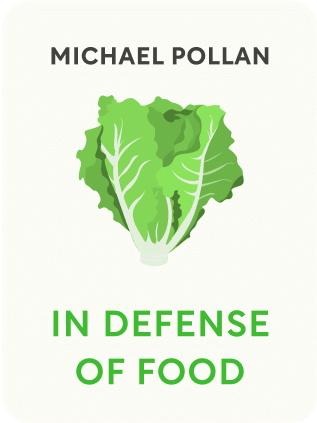

This article is an excerpt from the Shortform book guide to "In Defense of Food" by Michael Pollan. Shortform has the world's best summaries and analyses of books you should be reading.
Like this article? Sign up for a free trial here .
What is nutritionism? How has the ideology of nutritionism changed the way we determine the health value of food products?
Popularized by Michael Pollan in his book In Defense of Food, nutritionism refers to a paradigm which states that the value of food is determined solely by its constituent nutrients. Pollan argues that the ideology of nutritionism has distorted our understanding of healthy eating, such that even processed foods are believed to be healthy because they contain certain nutrients.
Keep reading to learn about the rise of nutritionism.
What Is Nutritionism?
“Nutritionism” focuses on the benefits of foods as a sum of their parts, rather than the whole. The term was coined by a sociologist as a way to explain this new way of regarding food and health. To understand what nutritionism is, you must understand a few key aspects encompassed in the term.
1. Nutritionism Is Not a Synonym for Nutrition
The suffix “-ism” denotes a system, philosophy, or ideology. Therefore, nutritionism is an ideological concept regarding the science of nutrition, not a field of that science. Ideologies are grounded in marginally examined hypotheses made about observed relationships among pieces of information.
Regarding nutritionism, the assumption is that nutrients are the gateway to understanding food, or the parts compose the whole. Because nutrients are invisible and intangible, a subsequent assumption is that the public is not equipped to understand their nuanced details. People must rely on science to tell them what the value of food is.
- Think of this idea as similar to religious faith and looking to a priest to bridge the gap between God and Heaven and the living world.
The reductionist assumption that food is eaten solely for health benefits is understandable when food is valued only as a vehicle for nutrient transportation. This assumption is further supported when science becomes the authority for disseminating the value of nutrients. The resulting mindset is that certain nutrients are valuable and certain nutrients are harmful.
2. Every Good Nutrient Must Have an Antagonist
To ensure the public’s interest in the good nutrient, a bad nutrient is offered up as the enemy. The past decades have seen wars waged between carbohydrates and proteins, proteins and fats, and fats and carbohydrates.
In addition to the conflicts between these “super power” nutrients, smaller civil wars are waged within each: simple carbs vs. complex carbs, animal protein vs. plant-based protein, and saturated fats vs. polyunsaturated fats. Currently, the virtuous omega-3 fatty acids are being promoted over the devious trans fats.
This type of nutritional duality creates an environment ripe for a revolving door of fad diets and shifting loyalties among nutrients. These shifts happen in the blink of an eye based on whatever way the science winds blow.
3. The Compounding Effects of Whole Foods Are Irrelevant
When we only consider foods as valuable for their nutrient make-up, we ignore the internal workings of whole foods. An example of this short-sightedness is the current state of milk.
Milk has become nothing more than a vessel for delivering protein, lactose, fat, and calcium. For decades, food science has attempted to simulate the beneficial effects of these nutrients in milk-like substances. From Liebig’s first attempt to develop a suitable baby formula, several other iterations have entered the market. However, despite the changing compositions of ingredients and added nutrients, there has never been a time when babies fed formula have thrived as well as those given human milk.
If baby formula has the same chemical compounds as milk, it should react similarly in the body. But it doesn’t. The question must be asked: What inherent interactions are happening within the whole milk product to create this advantage?
The boundaries between whole foods and processed foods diminish when food is only valuable as the sum of its parts. Nutritionism would have you believe that a box of cheese-food product fortified with essential nutrients is as healthy or healthier than actual whole milk cheese straight from the farm. This suggestion is extremely beneficial for the nutritionism movement, but it may be extremely dangerous to your health.
Nutrient Home Invasion
The relationship between nutritionism and processed food manufacturers is akin to that of criminals and accomplices. Stating that any food, even synthetic food, can be made healthy or healthier than real food through scientific modifications justifies the value of processed foods. This justification reinforces their appeal to the public. Yet, the modifications may not always lead to healthier people. The history of margarine is a good example.
In the 1800s, margarine was created from hydrogenated vegetable oil as a cheap alternative for butter. But after the lipid hypothesis, margarine manufacturers swept in with claims that their product was healthier than fat- and cholesterol-laden butter. The hydrogenated vegetable oil could be injected with all sorts of good nutrients to support optimal health.
Unfortunately, solidifying vegetable oil with hydrogen creates trans fats. At the time, no one knew that trans fats were even more dangerous than the saturated fats they were replacing. But once scientists saw the link between trans fats and killer diseases, margarine got a face-lift to reduce trans fats. A new war was waged against trans fats as though they’d never been promoted. This was a positive step for future consumers, but those who’d been eating margarine in good faith for decades may not have been so lucky.
How was it possible for this dangerous food source to rise to the status of shining star of nutritionism? Again, the U.S. government played a large role.
Validating Fake Food
Americans were almost saved from the manipulative marketing of the food industry, but the power of the industry thwarted that effort. In 1906, the publication of Upton Sinclair’s novel The Jungle created a crisis for the food industry. The novel exposed the horrific conditions and unethical processes involved in meat and by-product manufacturing. The public urged the government to do something to protect them from these adulterated and unhygienic products.
In response, the Food, Drug, and Cosmetic Act of 1938 created mandates requiring all synthetic foods be labeled “imitation.” The idea was simple: if a food was packaged to represent traditional real food but was modified in some way, it must be outed as such. Enter the food industry, which fought with everything it had for decades to repeal the mandate. They complained the rule undermined innovation in food science to address the lipid hypothesis and relationship between food and killer diseases.
The efforts of the food industry were again bolstered by scientific organizations. The American Heart Association spearheaded a campaign against saturated fats in favor of vegetable oil. It recommended that foods be modified to remove the bad fats and cholesterol. To ensure the public would eat these healthier foods, they promoted the removal of the “imitation” label. The AHA believed the label placed a negative light on modified foods.
With this scientific backing, the Food and Drug Administration adjusted the mandate in 1973. The new laws stated that any “imitation” product equal or superior to the real item in nutrient value could be sold without labeling it as synthetic. With this step, the FDA became the newest member of nutritionism, inducting the American public by proxy.
Food manufacturers had a field day without the restrictive labeling requirements. Any food with “unhealthy” natural fat, such as yogurt and cream, could be modified with hydrogenated oil. Soy protein could now masquerade as animal protein in products like Bacon Bits. Egg substitution products appeared on the scene, joined by non-dairy creamers.
The assumption was that science could perfectly simulate the benefits of real foods without the negative natural components. But as the baby formula example illustrates, that claim has never been validated. Still, the passive public were none the wiser, and the food industry was off to the races. Enter the golden age of processed food.

———End of Preview———
Like what you just read? Read the rest of the world's best book summary and analysis of Michael Pollan's "In Defense of Food" at Shortform .
Here's what you'll find in our full In Defense of Food summary :
- Why eating a Western diet is killing you
- How the rise of low-fat foods contributed to the rise of obesity and diabetes
- What to eat if you want to restore a healthy relationship with your food






